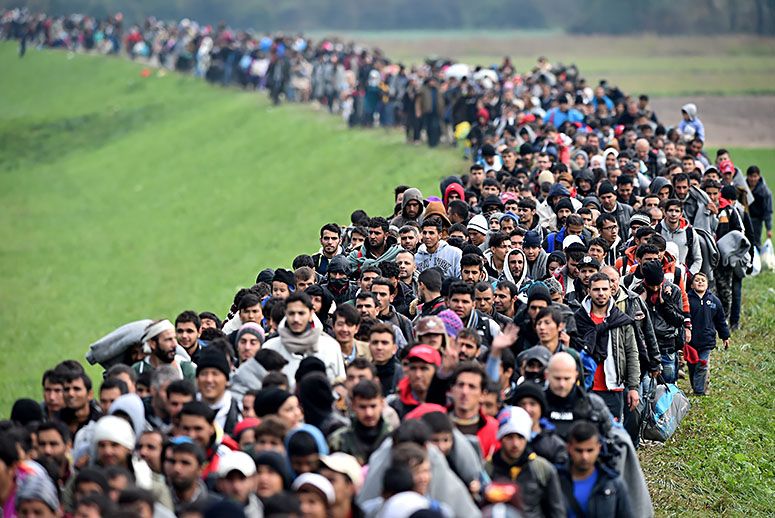In the wake of the tragic Paris attacks, and the San Bernardino shooting, GOP front-runner Donald Trump caused a media frenzy by calling for a “total and complete shutdown of Muslims entering the United States.” Afterwards, the Muslim American community and Syrian refugees were targets of malicious political rhetoric. The negativity against the refugee community intensified after a suspect believed to be involved in the Paris attacks was identified as a Syrian refugee.
Some embraced and perpetuated the hostile commentary while others went out of their way to show support for the refugees. Even President Obama weighed in via social media, commenting on a photo that told the story of Dr. Refaai Hamo, the Syrian Scientist who lost his wife and daughter in a Syrian government anti-personnel missile strike.
President Obama commented, “As a husband and a father, I cannot even begin to imagine the loss you’ve endured. You and your family are an inspiration. I know that the great people of Michigan will embrace you with the compassion and support you deserve. Yes, you can still make a difference in the world, and we’re proud that you’ll pursue your dreams here. Welcome to your new home. You’re part of what makes America great.”
President Obama has pledged to accept more than 10,000 displaced refugees from the Syrian war into the United States over the next year. However, more than half of the governors in the United States oppose letting refugees into their States. For example, Republican Governor of Iowa Terry Branstad, released a statement, “Until a thorough and thoughtful review is conducted by the intelligence community and the safety of Iowans can be assured, the federal government should not resettle any Syrian refugees in Iowa.”
Eleanor Acer of Human Rights First, a New York-based nonprofit, responded, “Ten thousand is just an embarrassingly low number given the scale of this crisis and that the U.S. has long been a global leader in resettlement.”
But are Syrian refugees dangerous?
In response a senior level State Department official answered,“The vast majority of resettled refugees go on to lead productive lives, receive an education, gain employment and support their families.”
Elan spoke with a Syrian refugee, who currently resides in the United States for the past four years. Amro, who chose not to reveal his last name, is a fashion stylist to celebrities. He says, “I always believed in the American Dream. I believe moving to America is the best thing that happened to me.”
He recently has styled, JLo, 50Cent, Missy Elliott, Nikki Minaj, Uma Thurman and even Zayn Malik. He continued, “I always had a passion for fashion and New York opened so many doors for me in that world.”
The State Department holds the position that “Refugee communities have historically contributed to the economic dynamism and cultural vitality of our nation. Refugees start businesses, join the U.S. military, and contribute to the United States in numerous ways.”
Amro’s styling talent is a prime example of that, but despite many benefits, the United States has drastically reduced the amount of refugees it lets into the country. The Washington director of the Human Rights Watch, Sarah Margon says, “The system is just too bogged down in bureaucratic impediments,” she says. The United States recently capped their annual refugee intake at 70,000, while Germany has pledged to take in nearly 800,000 Syrian refugees.
How does the Selection Process Work?
The United Nations High Commissioner for Refugees (UNHCR), is the international body in charge of protecting and assisting refugees. The UNHCR also identifies which refugees are candidates for resettlement in a third country (their new home). The State Department says they review the suggestions and, “The US program seeks to admit some of the most vulnerable refugees, particularly female-headed households, children, survivors of torture, and individuals with severe medical conditions.”
The average processing time for a Syrian refugee is about 18 to 24 months, but Syrian applicants can take longer due to security concerns. Several departments like; the Department of Homeland Security, the Defense Department, the National Counterterrorism Center and the Federal Bureau of Investigation are all involved in the process. The agencies use biographical details like: family history, friendships, social or political activities, employment, phone numbers, email accounts, and biometrics to make sure the refugee is who he/she says they are.
Once they have completed that process, the refugee is then paired with a resettlement agency in the Untied States to help with their transition. The organization provides support and vocational training until they are settled. The State Department official elaborated that they, “do not track refugees once they in the United States.”
Where do we go from here?
In a closed door meeting last month, Secretary John Kerry explored increasing the number of refugees from the annual 70,000 to 100,000. The extra 30,000 refugees would be from Syria. He said if it were to happen, it wouldn’t be until the following year.
Several million Syrians have been displaced due to the conflict in their country. Some are the most vulnerable of refugees: torture survivors, people with special medical needs and women who head households. More than half are children.
As Amro, aptly stated, “It’s really upsetting to see the negative comments about Syrian refugees, but as I always said no one will leave their home if he has a safe place. There is no place like home, ever.”




















Great one…..I would like to thank the writer and Mr. Amro for highlighting this important subject, we are really proud of you “Amro” you are giving a good example of Syrians